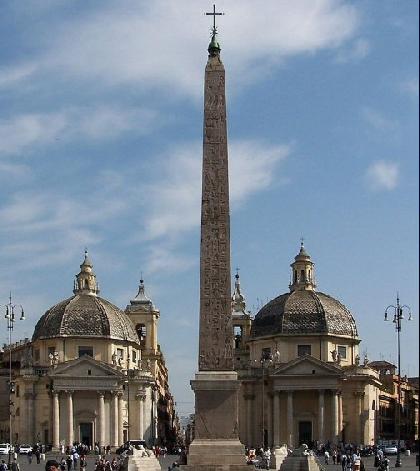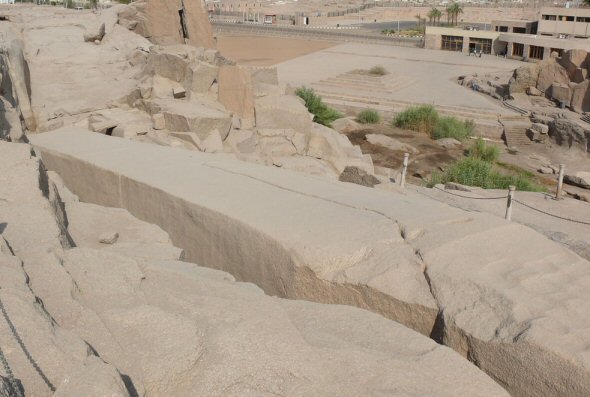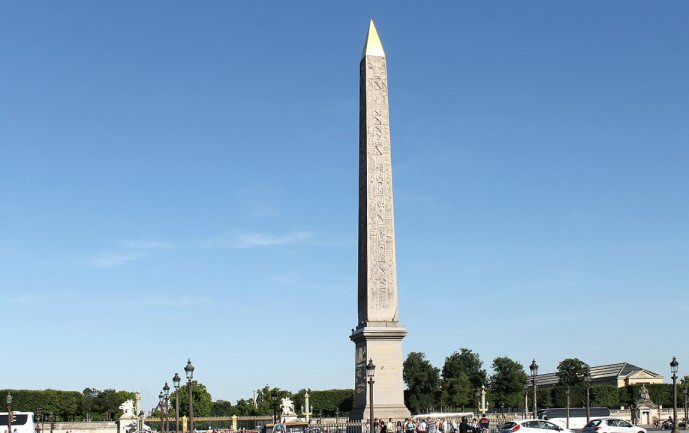An obelisk is a four sided single piece of stone standing upright, gradually tapering as it rises and ending in a small pyramid called a “pyramidion.” Obelisks always attracted attention by their polish, their decoration , and above all their lofty height. Whether they are still standing in their original places in egypt or adoring a square in another country. They were signs of victory to the ancient Egyptian, and the inscriptions carved on them record the titles and achievements of the Pharaohs. Obelisks known in the sacred ancient Egyptian language as benben or Tekhenu . When the Greek became interested in Egypt, obelisks attracted their attention and they gave the name “obeliskos” from which the modern name is derived. In Arabic the term is Messalah, which means a large patching needle and it has a reference to the object’s form. Obelisks are impressive not only for their lofty size and graceful form, but also for their marvelous polish and beautiful decoration. No one can deny that the Egyptians were very skillful in producing such wonders with relatively primitive techniques. The pharaohs used to make obelisks of granite and specially the larger ones. A few were made of quartzite and basalt. Granite whether red or black is found in Egypt only in the area around Aswan. The most important quarries were those of the island of Elephantine and Seheil, those near the unfinished obelisk, and those in shellal opposite the island of Philae.
How Obelisks Were Produced
There are many theories regarding the ancient Egyptian techniques in producing and raising obelisks. The obelisk was roughed out at the quarry, and shipped down the Nile to the point closest to its intended site. All sites in Egypt are close to the Nile. It was dragged out by men on ropes, it and probably they sliding on mud. It was finished and lettered in place, then laboriously erected by levering it up and building a mound of earth under it, until it could finally be pulled upright. When Augustus moved obelisks 1500 years later, he had pulleys and cranes and wheels,
which the early Egyptians did not have. The Unfinished Obelisk at Aswan The unfinished obelisk still lies in its quarry. It is the largest known ancient Egyptian obelisk ever erected, located in the northern region of the stone quarries of ancient Egypt in Aswan. A close look to aswan unfinished obelisk enabels the visitors to realise, not only the immense labour expended in transporting and raising such a giant block of stone, but also the heartbreaking failures which the egyptian engineers and workers had when they found the unexpected fissure on their amazing giant obelisk
Obelisks Around The World
Obelisk of Flaminio in Rome : Erected By : Seti I / Ramesses II Height: 24 m Location: Rome - Piazza del Popolo Note: Originally from Heliopolis. Brought to Rome by Augustus in 10 BC with the Solare obelisk and erected on the spina of the Circus Maximus.
Obelisk of Solare in Rome : Erected By : Psammetichus II Height: 21.79 m Location: Rome - Piazza di Montecitorio Note: Originally from Heliopolis. Brought to Rome by Augustus in 10 BC with the Flaminio obelisk to form the gnomon of a sundial on the Campus Martius. Found in 16th century but reburied. Rediscovered and erected by Pope Pius VI in front of the Palazzo Montecitorio in 1792.
Obelisk of Matteiano in Rome : Erected By : Ramesses II Height: 2.68 m Location: Rome - Villa Celimontana Note: The smallest obelisk in Rome. Originally one of a pair at the Temple of Ra in Heliopolis, the other being the Macuteo which retains much more of its original height
Obelisk of Ramesses II in Florence : Erected by: Ramesses II Height: 4.87 m Weight: 4.5 tons Location: Florence - the Boboli gardens in the Pitti Palace Note: The obelisk of Ramesses II, was erected originally in the temple of The Sun in Heliopolis, possibly it is twin, of which it is in Rome, The Dogali obelisk.

Obelisk of Theodosius in Istanbul:Erected By : Tuthmosis III Height: 25.6m Including the pedestal Location: Istanbul Note: Originally erected by The Great Pharaoh Tuthmosis III to the south of the seventh pylon of the great temple of Karnak. The Roman emperor Constantius II had it and another obelisk transported along the river Nile to Alexandria to commemorate his ventennalia or 20 years on the throne in 357
Obelisk of Ramesses II in Cairo : Erected By : Ramesses II Height: 13,5 m Location: Cairo - Al Andalus Garden in Gezira Island Note: was originally erected in Tanis 110 km northeast of Cairo, it was transported to Al Andalus Garden in Gezira Island, Cairo, in 1958, because there was no obelisk in the capital city of Egypt.
Obelisk of Sesostris I in Heliopolis Cairo : Erected by: Sesostris I Height: 20, 5 m Weight: 120 tons Location: At the entrance of the Sun temple in Heliopolis Note: Erected in 1942 B.C. It’s the oldest obelisk surviving. In its inscription it say: "The first occasion to The Jubilee, made to give it life for always".
Obelisk of Queen Hatshepsut at Karnak : Erected by: Queen Hatshepsut Height: Approximately 30 meters Weight: Over 300 tons Location: At Karnak Great Temple of Amun Note: The Obelisk of Queen Hatshepsut is made of red granite quarried from Aswan. It is the tallest obelisk in Egypt. Queen Hatshepsut is said to have built at least 4 other obelisks as monuments to her reign as female pharaoh.
Obelisk of Ramesses II at Luxor Temple : Erected by: Ramesses II Height: 22,55 M Weight: 227 tons Location: luxor Temple Note: it is one of a pair were built in front of the temple of luxor, the other one is now in the square of concorde Paris.
Cleopatra’s Needle in New York : Weight: 244-ton Location: in Central Park Note: After the legendary opening of the Suez Canal In 1869, Ismail Pasha, the Khedive of Egypt, first mentioned the gift of one of the obelisks to the United States in the hope of cultivating trade relations.
Obelisk of Concorde in Paris : Erected by: Ramesses II Height: 23 m Weight: 250 tons Location: in the Place de la Concorde Note: It’s one of Cleopatra’s needles, it once marked the entrance to the Luxor Temple. The viceroy of Egypt, Mohamed Ali presented the 3,300-year-old Luxor Obelisk to France in 1826. King Louis-Philippe had it placed in the centre of Place de la Concorde in 1833, in return the king gave Mohamed Ali a watch which is now placed on his famous mosque in Cairo and it never worked.


